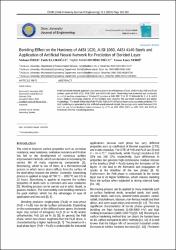Boriding effect on the hardness of AISI 1020, AISI 1060, AISI 4140 steels and application of artificial neural network for prediction of borided layer

View/
Access
info:eu-repo/semantics/openAccesshttp://creativecommons.org/licenses/by/3.0/us/Date
2024Metadata
Show full item recordAbstract
Artificial neural network approach was used to predict the thicknesses of total (FeB+Fe2B), FeB and Fe2B borides layers of AISI 1020, AISI 1060, and AISI 4140 steels. Boronizing heat treatment was conducted in a solid medium comprising of EKabor®2 powders at 840–960 ˚C at 40 ˚C intervals for 2, 4, 6, and 8 hours. Optical microscope analysis of the borided layer revealed the saw-tooth (columnar) and planar morphology. The depth of the total (FeB+Fe2B), FeB and Fe2B boride layers was accurately predicted. For total boride layers generated by the artificial neural network model, the average error varied between 0.04 and 7.64 µm. Micro hardness values increased by 423% in AISI 1020, 336% in AISI 1060, and 411% in AISI 41040 after the boronizing process.
Source
Dicle Üniversitesi Mühendislik Fakültesi Mühendislik DergisiVolume
15Issue
1Collections
The following license files are associated with this item:


















